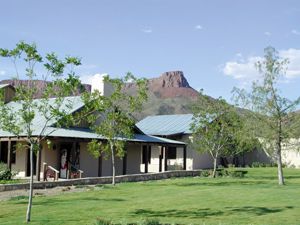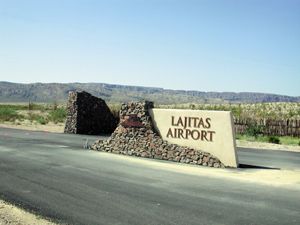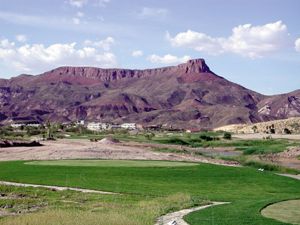|
|
 |
| SW Aviator Magazine is available in print free at FBOs and aviation-related businesses throughout the Southwest or by subscription. |

|
 |

|
 |
 |
 |
|
The web's most comprehensive database of Southwest area aviation events.
|

|
 |

|
 |
|
Featured Site:
|
|
|
 |
|
A continuosly changing collection of links to our favorite aviation related web sites.
|

|
 |

|
 |

|
 |
Search by:

|
|
|
Or enter a keword:

|
|
|
Post a FREE Classified Ad 
|
 |
|

|
Good Landings in the Texas Badlands
|
|
Lajitas, Texas
|
 Story and photos by Susan Love Fitts Story and photos by Susan Love Fitts
There’s nothing shy about Texas. Not it’s legends, like Stephen F. Austin, Sam Houston, or Judge Roy Bean, nor its landscape, stretching from the piney woods of its eastern boundary to the barren beauty of its western edge and the frontier flavor of small border towns down on the Rio Grande. The spectrum of Texas landscapes became evident on a recent flight from Houston to Lajitas, one of those old west border towns, which has recently undergone a striking metamorphosis from its former self, the desert fly-in adventure that was previously described in SW Aviator (Oct./Nov 1999).
As we flew westward, the blanket of sharp geometric green shapes of sub-tropical Houston slowly began to soften and morph into the sepia swirls of the Great Chihuahuan Desert. Since unscheduled excursions to and fro over the Rio Grande border with Mexico are frowned upon by both governments, we kept well north of the river in order to avoid a military escort into nearby Laughlin AFB in Del Rio. Eventually we were approaching the 8,000 ft. peaks of the Chisos Mountain range in the Big Bend National Park. Big Bend is the southernmost part of this half of Texas, so named for the sharp bend of the river toward the northeast.
Lajitas is nestled on the Rio Grande a few miles west of the majestic Chisos, between the Big Bend National Park and the Big Bend Ranch State Park. The name Lajitas is Spanish for "little flat rocks" and refers to the Boquillas flagstone of the area. In the early 20th Century, Lajitas became a military outpost commanded by famed U.S. Army General "Black Jack" Pershing, who led forces in pursuit of the notorious Mexican bandit Pancho Villa. Mercury mining in the Chisos Mountains attracted prospectors, and dinosaur bones found throughout the area indicate a much earlier life in the valley. Today, Lajitas is a beautiful golf oasis in the middle of the "baddest" Texas badlands.
This was our first visit to Lajitas since the old landing strip (17XS) was closed and bulldozed to make way for new facilities, which the new owner, Stephen R. Smith, is installing to make Lajitas Resort a world class vacation retreat and residential development. He calls it the "Ultimate Hideout." Those familiar with the Spartan facilities and deteriorating gravel runway of the old airstrip will be amazed when they land at the new Lajitas Airport, located in the desert 4.2 miles east of town. We approached runway 7, the new 7500’ x 100’ asphalt runway, and found the approach and landing much more routine than with the older airstrip, where nearby Lajitas Mesa and some other hills formed an obstacle course on the approach over the Rio Grande onto the uncertain surface of the gravel runway. The new runway is free from obstructions, but there is a mesa ridge south of the runway that should be given due respect. If landing on Runway 7, you will have a wonderful view of the magnificent Chisos Mountains several miles beyond, but they are too far away to pose a problem in VFR weather.
 The new airport is strictly first class. It has high intensity landing lights, hangar and car rental facilities, and full 100LL and jet fuel service. A luxurious FBO building is scheduled for a spring 2003 opening. The improvements are more than just cosmetic. These new facilities make it possible to fly into Lajitas without the hassles endured with the older airstrip, such as having to make extra fuel stops in Marfa or Alpine, and in trying to arrange for a car rental to be delivered from nearby Terlingua. The new airport obviously provides Smith with a first class facility for his own fleet of jet airplanes, but his real objective is to make Lajitas a convenient stop for all pilots and aircraft types. Smith’s ultimate purpose is the economic development of the entire area, not just the Lajitas resort. The new airport is strictly first class. It has high intensity landing lights, hangar and car rental facilities, and full 100LL and jet fuel service. A luxurious FBO building is scheduled for a spring 2003 opening. The improvements are more than just cosmetic. These new facilities make it possible to fly into Lajitas without the hassles endured with the older airstrip, such as having to make extra fuel stops in Marfa or Alpine, and in trying to arrange for a car rental to be delivered from nearby Terlingua. The new airport obviously provides Smith with a first class facility for his own fleet of jet airplanes, but his real objective is to make Lajitas a convenient stop for all pilots and aircraft types. Smith’s ultimate purpose is the economic development of the entire area, not just the Lajitas resort.
Airport manager Lee Goggins, a retired Delta Airlines maintenance manager, gave us a tour of the new FBO facility-in-progress. Plans for the new terminal building include a pilot’s lounge, a snack area, and an office complete with computers for flight planning and filing. Although still under construction when we were there, the building was already showing signs of being architecturally striking, with the ceiling sporting enormous beams, made from pine logs brought in from New Mexico. Goggins showed us the aviation fuel farm, which, of course, is brand new and modern in every respect. Fuel is delivered to airplanes by a new fuel truck. Tie down service is free with fuel purchase and $10.00 per night without. Hanger service large enough for the biggest jets is available for an extra charge. We also saw the emergency power plant, which kicks in if needed to keep the runway lights bright for night landings, which, incidentally, were not permitted at the old airstrip. Lights will eventually be pilot-controlled on the airport Unicom frequency 122.9. Until then, just call the Lajitas Resort (915-424-5000) to arrange for lights if you want to arrive at night. Goggins also handles a fleet of brand new SUV’s, which can be rented at the airport for $150 per day. The Unicom frequency is guarded by the Lajitas Resort hotel desk, so there is no airport advisory available at the present time. If you want transportation from the airport to the resort, just call the desk on 122.9 and they will provide transportation to the Badlands Hotel free of charge.
The new airport identifier is 89TE. A GPS approach will eventually be surveyed, and the airport will probably be charted on the next revision of WAC and Sectional charts. Richard Hubbel, Operations Manager of Lajitas Resort, told us air traffic is building, and is up to approximately 10-15 landings a week now. Long-range plans for the airport (in 3-5 years) include an adjacent Air Park Community with a golf course and 50 ten-acre lots, some with individual access to the runway.
 Smith, who calls Austin home, purchased the 25,000 barren acres of desert land in February 2000 at auction from Walter Mischer, a Houston developer. Smith paid $4.25 million for his piece of Texas desert, with a plan to turn Lajitas into the Ultimate Hideout, offering guests the finest of rugged luxury. To achieve this goal, Smith has already invested an additional $50 million in the airport and other facilities. He estimates that a total investment of $100 million will be required to bring his Ultimate Hideout to fruition. You can buy your own personal hideout in Lajitas for prices ranging up to a million dollars. Smith, who calls Austin home, purchased the 25,000 barren acres of desert land in February 2000 at auction from Walter Mischer, a Houston developer. Smith paid $4.25 million for his piece of Texas desert, with a plan to turn Lajitas into the Ultimate Hideout, offering guests the finest of rugged luxury. To achieve this goal, Smith has already invested an additional $50 million in the airport and other facilities. He estimates that a total investment of $100 million will be required to bring his Ultimate Hideout to fruition. You can buy your own personal hideout in Lajitas for prices ranging up to a million dollars.
Smith is well on his way to establishing the Lajitas Resort and Golf Club into a first-class resort experience. Our room in the Cavalry Post was outfitted in authentic "Texas Frontier" décor and faced out into a courtyard and a long reflection pool that made you cool just to look at it. All the rooms in the Cavalry Post have been completely updated by Smith, who spent about $30,000 per room on the renovation. Room rates at the resort range from $125-$225 during the peak season, October 1 – May 31, and $95-$150 the rest of the year. This desert retreat is truly that – a retreat from cell phones (because they don’t work out here), and a retreat from the noise of the city. With its peaceful blue sky days and quiet, brilliantly starred nights, a visit to Lajitas will convince you that the "badlands" can be beautiful, both from the air and on the ground.
We ate lunch one day and dinner the next at the informal Candelilla Café. A new dining venue, the Ocotillo, opening this Fall, will offer western nouvelle cuisine prepared under the direction of Chef Jeff Blank and Shanny Lott, owners of Austin’s famed Hudson’s on the Bend restaurant. Conde Nast named Hudson’s one of the top 50 restaurants in the United States. In the introduction to Hudson’s cookbook, Cooking Fearlessly, Dan Rather wrote, "These guys could cook a horseshoe and make it delicious. Instead, they specialize in dishes such as Hot ‘n Crunchy Trout… and Corn Pudding. But their ever-changing, brave menu regularly lists…buffalo, antelope, armadillo – hell, even rattlesnake."
The Thirsty Goat Saloon is the resort’s popular watering hole, named for Lajitas’ duly elected mayor – a goat named Clay Henry III. Clay Henry become famous for his thirst for Lone Star Beer, and is still a frequent visitor in the saloon, putting away the Lone Stars whenever anyone offers them.
 Golfers familiar with the old 9-hole golf course will not recognize the new 18-hole course, The Ambush, a challenging 7,042-yard course created by Austin golf course designers Roy Bechtol and Randy Russell. Inspired by the natural setting, Bechtol and Russell created the par 71 course, which opened May 2002, to reflect the area’s rocky desert elevations. Golfers familiar with the old 9-hole golf course will not recognize the new 18-hole course, The Ambush, a challenging 7,042-yard course created by Austin golf course designers Roy Bechtol and Randy Russell. Inspired by the natural setting, Bechtol and Russell created the par 71 course, which opened May 2002, to reflect the area’s rocky desert elevations.
The Ambush actually has a 19th hole, although it is neither a watering hole nor a tiebreaker. Hole 11a is novel: an optional par one that plays into Mexico! Kiss your ball goodbye before you sling it across the Rio Grande, to a south-of-the-border green about 100 yards away. Since there’s no border crossing, and therefore no way to putt out, Bechtol and Russell have sculpted a green into a slightly concave surface that will encourage holes-in-one, thus creating a truly memorable international experience. Also on the drawing board is a second golf course called The Outlaw, and an architecturally striking golf clubhouse and grill, slated to open in 2003. The facility will include a fully stocked pro shop, locker rooms, restaurant, and lounge.
The new Equestrian Center, complete with barns, covered and open-air riding arenas, and a trail system, is available now; and for visitors who want to shop, there is the western-style boardwalk of boutiques and shops.
Plans also include a luxurious back-to-nature spa and health institute named Agave. Scheduled for opening in 2003, the spa will pamper guests with a wide range of wellness services to refresh and renew the body, mind, and spirit. The spa will offer a full range of therapeutic body and skincare treatments, nutritional counseling, and wellness services and experiences such as massage therapy, mud and hot rock treatments, yoga, tai chi, and guided nature walks.
We left the luxury of the resort for one night and drove to nearby Terlingua for a margarita at the Starlight Saloon. There we visited with Ken Barnes, a self-taught paleontologist who has been digging up fossils and dinosaur bones since he first came out this way a little more than a decade ago. Barnes is now busy creating and directing the Lajitas Resort Paleontology Museum, which will display fossilized remains of the region’s distant past.
From there we trekked to La Kiva, another Terlingua watering hole, where we heard murmurings about the recent border closings. On May 10, 2002, fortified with Homeland Security resources (new aircraft, patrol cars, and 20 new agents) the U.S. Border Patrol closed the Lajitas border crossing, as well as the crossings at Santa Elena and Boquillas. The closings have divided families and caused job losses. Perhaps the most troubling consequence is that children in the Mexican town of Paso Lajitas are no longer able to attend school in Terlingua, the only school within a reasonable distance. Ed Spengeman, real estate sales manager for the resort, told us that Smith had offered to build a Lajitas border crossing rivaling the one at Presidio, but the U.S. Border Patrol declined his generosity.
Also heard at the Starlight Saloon that night was talk of the new development, and what it will do to the peaceful desert landscape. Some want things to stay the way they were before the Lajitas developers came. However, one lady said she welcomed the renewal, because it brought Smith to their area. She praised Smith for donating funds to a local charity she worked with, to area schools, and to other community and service groups.
Like other Texans before him, Smith is not shy in pursuing his monumental objectives, nor does he shrink from offering a helping hand. And he’s made the Lajitas badlands a much friendlier place to land.
|
 The new Lajitas Airport is located 4.2 sm east of Lajitas, rough GPS coordinates are N 29º 16 66, W 103º 41 34. Runway 7-25 is 7500 x 100, asphalt, and in brand new condition. Field elevation is 2630. This private runway is available by prior arrangement only, make arrangements through the hotel at 915-424-5000. No touch and go landings permitted. Visit www.lajitas.com/directions.html for more information. The new Lajitas Airport is located 4.2 sm east of Lajitas, rough GPS coordinates are N 29º 16 66, W 103º 41 34. Runway 7-25 is 7500 x 100, asphalt, and in brand new condition. Field elevation is 2630. This private runway is available by prior arrangement only, make arrangements through the hotel at 915-424-5000. No touch and go landings permitted. Visit www.lajitas.com/directions.html for more information.
The nearest nav aid is the Marfa VOR (MRF), approximately 62 miles northwest. Other area airports are Marfa (MRF) and Alpine (E38), Texas, both have fuel available and IFR approaches. Big Bend State Park (3TE3) is strictly VFR and has no fuel. There are numerous private airstrips in the area, some of which are charted. |
Click here to return to the beginning of this article.  |
|